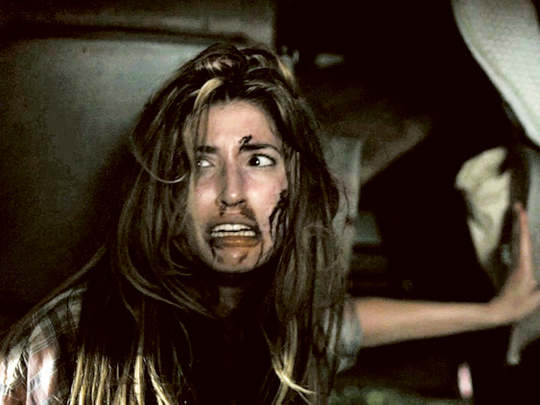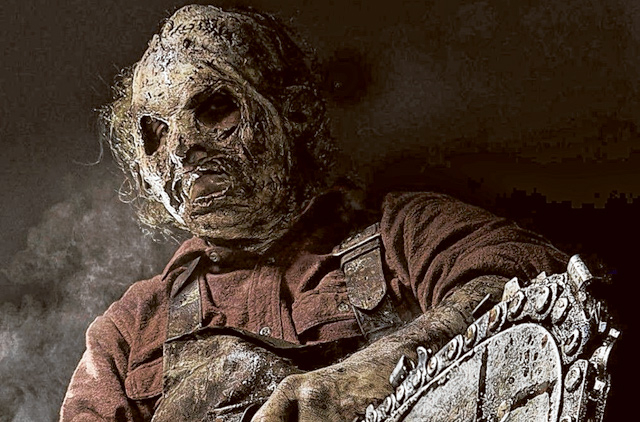
It might not be as well known to some moviegoers as “Friday the 13th,” “Nightmare on Elm Street” or “Saw,” but “The Texas Chainsaw Massacre” ranks high among the most revered titles in the horror genre.
The 1974 serial killer story by Tobe Hooper sent five friends into the clutches of the Sawyer family, a clan of rural cannibals. Although the film’s central villain, the power tool-wielding Leatherface, lived on in sequels and a 2003 remake, the series has lain dormant since 2006’s “The Texas Chainsaw Massacre: The Beginning.”
Now, director John Luessenhop (“Takers,” “Lockdown”) and a team of producers are resurrecting Leatherface with “Texas Chainsaw 3D.” The movie opens Friday and is expected to do strong business of as much as $18 million in its debut weekend.
“From the beginning, it’s been a mismanaged franchise — a boat that drifted off course,” said Carl Mazzocone, the producer most active in securing rights for and developing the new film. The fact that there are far more producers — 15 — listed in the credits of “Texas Chainsaw 3D” than there are maimed corpses in the sequel itself, is proof not only of how complicated it can be to relaunch a horror franchise, but also of Luessenhop’s desire to dial down the film’s body count.
The new film emphasizes a storyline about the relationship between a woman named Heather (Alexandra Daddario) and Leatherface (Dan Yeager), who share common kin. In the story, Heather inherits a home whose cellar happens to be occupied by a rather antisocial relative.
“What if you discovered the only family left to you was a monster?” Luessenhop said. In fall 2008, Mazzocone travelled to Austin, Texas, to meet with the representatives controlling the “Texas Chainsaw” rights. The producer’s pitch was simple: The story of Leatherface should be as popular as the “Saw” movies, which Mazzocone and producer Mark Burg’s Twisted Pictures had made.
“I told them we needed to put some level of integrity into the story,” Mazzocone said. While the basic terms of the deal were hammered out in about 15 minutes, it took more than a year to finalize the contract and even longer to assemble a script that felt both fresh and reverential.
Mazzocone needed someone to bankroll the production. Lionsgate, which had released the “Saw” films and felt like a natural home for a new “Texas Chainsaw” film, was focused at the time on fending off takeover investor Carl Icahn and launching its “Hunger Games” series.
Eventually, the project made its way to Campbell Grobman Films, a new company formed by Christa Campbell, an actress and former pinup girl, and Lati Grobman, a producer who had a long partnership with Avi Lerner and his Millennium Pictures.
“We were taking meetings with other directors and writers pitching ideas of what could be the next big franchise,” said Campbell, who has acted in a number of horror movies including “2001 Maniacs,” “Day of the Dead” and “The Tomb.”
Added Grobman: “I know nothing about horror. I’m not a fan of it. But Christa knows the market, she knows the people. She’s the queen of horror.”
Lerner wasn’t inclined to finance the film, which was budgeted just below $20 million (Dh73.4 million). Millennium specializes in action movies featuring actors with international appeal — “The Expendables,” with Sylvester Stallone and Jason Statham, a perfect example of his taste — not horror tales with no-name performers. Lerner also likes to shoot his movies in places like Bulgaria to keep costs down, no small problem for a movie with Texas in its title (it was ultimately shot in Louisiana). “We would not leave Avi alone,” Grobman said.
“I think he made the movie just because he wanted us to stop bugging him.”
With the money in place, Mazzocone turned to Luessenhop to direct, despite the fact that he had never made a horror film before.
The movie is credited to screenwriters Adam Marcus, Debra Sullivan, Kirsten Elms and Stephen Susco based on characters created by Kim Henkel and Hooper, and Luessenhop worked closely with Mazzocone in revising their screenplay
In earlier scripts, Leatherface would deflect bullets with his chain saw; Luessenhop believed those kind of superhuman feats undermined his credibility as a villain. By establishing that familial tie and reinforcing Leatherface’s origin story (using 15 minutes of footage from Hooper’s original in a prologue), Luessenhop thought the film would feel less gothic.
“It’s all about humanizing this guy that makes the movie,” the director said.
“He’s damaged, abused, stunted — but lethal.” Yet not too deadly. Several characters meet gruesome ends, but the carnage is modest given the title.
“I kept the body count low on purpose,” Luessenhop said. “It desensitizes you if you do it too much.” Along the same lines, the stereoscopic effects, mandated by the global success of 2010’s “Saw 3D: The Final Chapter,” were kept to a minimum.
The movie, which Millennium sold to Lionsgate for domestic distribution, was originally set to open October 26 of last year, but its proceeds would have been hurt by Superstorm Sandy, which reached its peak intensity a day earlier. The January date gives the sequel a quick but open berth, as it is the only new film in wide release this weekend — although it’s still opening in the aftermath of a national tragedy, the shootings at Sandy Hook Elementary in Newtown, Connecticut, which has rekindled debate about violence in films and other popular entertainment.
Although it’s too early to say if there’s another “Texas Chainsaw” movie in the immediate future, Mazzocone and his producing partners are confident. “I believe we made a classic monster movie,” Mazzocone said. “Many ‘Texas Chainsaw Massacre’ films have exploited more of the slasher aspects of the genre. This one doesn’t.”
—LAT












